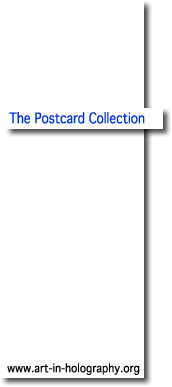

Holograms have earned their reputation through their ability to reproduce the three dimensions of space, but they also provide us with a fascinating alternative to traditional representations of time.
If photography can be defined as the representation of a particular instant in time, holography offers the possibility to capture duration in space. By moving in front of a hologram, the viewer will relive the successive stages of an event that occurred over a period of time. It is a relativistic visual universe in which space bends to accommodate movement. Here, as opposed to the cinema and television, time does not slip through our fingers. Like a book whose pages would turn at the eyes' command, viewers control the passage of the time represented. The experience is troubling and radically modifies our approach to animated images and more basically our relation to images. If only for this reason (and there are many others), holograms are of immediate concern to all those interested in the visual arts.
Jean François Moreau spoke in Time Versus Space: Holographic Kinetics
French text
White light transmission hologram. Produced with Kirk Woolford.
Photo © Jean-François Moreau
